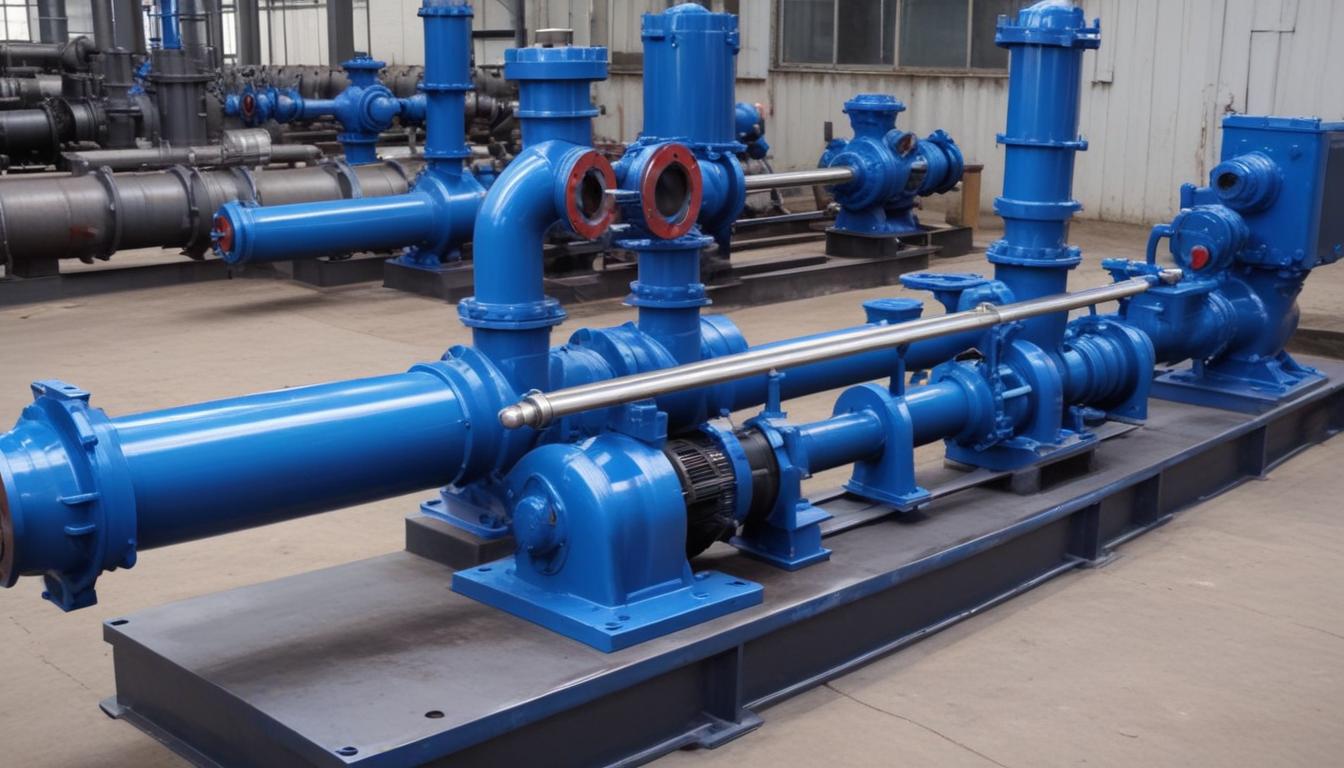Why progressive cavity pumps are crucial for chemical industries
Progressive cavity pumps offer numerous benefits that are crucial for enhancing efficiency and reliability in the chemical processing sector. One of the primary advantages of these pumps is their ability to handle viscous fluids and slurries with ease, making them ideal for various chemical applications. Their unique design features consistent flow rates, regardless of viscosity changes in the fluid, which is of significant importance in maintaining process stability.
Another notable benefit is the reduced shear during fluid transfer. This characteristic is particularly valuable in the chemical industries where sensitive materials, such as polymers and emulsions, are frequently used. The gentle pumping action minimizes the risk of damaging these materials, ensuring product integrity throughout the process.
Maintenance and operational costs are also minimized with progressive cavity pumps due to their simple construction and low wear rates. The reduced number of moving parts leads to lower breakdown frequency and easier maintenance, making them a financially sound choice for continuous operation in chemical environments.
Additionally, progressive cavity pumps can operate efficiently across a wide range of pressures and temperatures, making them versatile tools for various chemical processes. Applications include the transfer of fluids such as acids, caustics, and other aggressive liquids, further demonstrating their robustness in challenging chemical environments.
In conclusion, the importance of progressive cavity pumps in chemical processing cannot be overstated. Their ability to deliver consistent performance, handle demanding materials gently, and maintain low operational costs positions them as indispensable assets in modern chemical industries.
Mechanisms of progressive cavity pumps
Progressive cavity pumps operate through a unique mechanism that consists of an inner rotor and an outer stator, forming a series of cavities or chambers. As the rotor turns within the stator, it creates a progressive flow of fluid through these cavities. This mechanism is designed to provide a smooth and continuous flow, which is essential for maintaining process efficiency in the chemical industries. The rotor’s motion is helical, which allows for the movement of the fluid with minimal turbulence, further emphasizing the pump’s ability to handle sensitive materials.
One of the key features of progressive cavity pumps is their positive displacement nature. Each rotation of the rotor draws in a specific volume of fluid, which is then expelled at the discharge end. This characteristic ensures a consistent flow rate regardless of changes in the fluid viscosity or variations in pressure, making these pumps particularly suited for chemical processing. The ability to maintain a steady flow reduces the likelihood of pulsation, which can adversely affect downstream processes.
Another significant aspect of the mechanism is adaptability. Progressive cavity pumps can be customized with rotors and stators made from various materials to resist corrosion and abrasion caused by aggressive chemicals. For example, pumps used for transferring strong acids may have components constructed from materials such as Hastelloy or PTFE (Polytetrafluoroethylene), which provide enhanced durability and longevity under harsh conditions.
To provide a clearer understanding, below is a summary of the components and operation of progressive cavity pumps:
| Component | Function |
|---|---|
| Rotor | Creates the pumping action by turning inside the stator, forming cavities for fluid transfer. |
| Stator | Houses the rotor and helps in forming sealed cavities to ensure efficient fluid movement. |
| Drive Shaft | Connects to a motor, providing motion to the rotor. |
| Base | Provides stability and support for the pump assembly, ensuring safe operation. |
Furthermore, the mechanism allows these pumps to handle a wide variety of fluids, including those with high solids content, without clogging or losing efficiency. This capability is particularly important in industries such as wastewater treatment, where mixed sludges must be moved reliably. The gentle and consistent pumping action is crucial in preserving the integrity of the materials while ensuring successful operation across numerous applications.
Applications in various chemical sectors

The versatility of progressive cavity pumps makes them invaluable across multiple sectors of the chemical industry. Their unique construction allows for effective handling of a broad spectrum of materials and conditions, making them suitable for numerous applications. Below are some key areas where progressive cavity pumps excel:
- Polymer Production: In the manufacturing of polymers, progressive cavity pumps are ideal for transferring viscous materials without causing shear damage. They ensure the materials remain homogeneous, which is critical for product quality.
- Paint and Coatings: These pumps efficiently handle thick paints and coatings, enabling consistent flow rates, which are essential for maintaining the desired properties of the final product.
- Food and Beverage Chemicals: Progressive cavity pumps are used in applications involving food-grade chemical processes, ensuring sanitary transfer of substances like sauces, syrups, and emulsifiers. Their ability to maintain hygiene standards while providing gentle handling of sensitive ingredients is crucial.
- Pharmaceutical Manufacturing: In pharmaceuticals, precise dosing is paramount. The consistent flow and ability to handle a variety of fluids make progressive cavity pumps suitable for the transfer of active ingredients and formulations.
- Wastewater Treatment: These pumps play a significant role in the handling of sludge and slurries in wastewater treatment. Their positive displacement design enables reliable movement of materials with high solids content, ensuring efficient treatment processes.
Particularly in chemical processing, the importance of integrating progressive cavity pumps into operations cannot be overstated. Their ability to maintain operational efficiency, reduce shear, and operate under varying conditions leads to enhanced productivity and reliability. Furthermore, manufacturers often incorporate pump customization options, allowing them to tailor solutions based on specific fluid characteristics and operational demands. This flexibility ensures that these pumps can adapt to the specific needs of any chemical sector, establishing them as a preferred choice among engineers and plant operators alike.
The application of progressive cavity pumps within various sectors of the chemical industry highlights their transformational role. From polymer production to wastewater management, these pumps are essential in optimizing processes and ensuring the seamless transfer of materials.
Maintenance best practices

Ensuring the reliability and efficiency of progressive cavity pumps is paramount for optimal performance in the demanding environments of the chemical industries. Maintenance best practices play a crucial role in prolonging the lifespan of these pumps, reducing downtime, and preventing costly repairs. A systematic approach toward maintenance can help in identifying potential issues before they escalate into severe problems. Here are some recommended best practices for maintaining progressive cavity pumps:
- Regular Inspections: Scheduled inspections should focus on wear components like the rotor and stator, which may exhibit signs of abrasion or degradation over time. Engineers should check for any visible damage or excessive wear and take corrective measures immediately.
- Systematic Lubrication: Proper lubrication of the drive assembly is essential for preventing overheating and minimizing operational wear. It is advisable to follow the manufacturer’s specifications regarding lubrication frequency and type of lubricant to be used.
- Monitoring Performance: Implementation of predictive maintenance through continuous monitoring of flow rates, pressure levels, and energy consumption can provide valuable insights into the pump’s operational condition. Any significant deviations from normal parameters should trigger an in-depth analysis for possible underlying issues.
- Seal Integrity Verification: Checking the integrity of seals and gaskets regularly can prevent leaks that may lead to material loss or contamination. If leaks are detected, replace the seals promptly to maintain efficiency and safety.
- Cleaning Protocols: Chemical deposits can accumulate within the pump and lead to reduced efficiency. Establishing a routine cleaning protocol helps to maintain the internal surfaces and ensures uninterrupted flow. Appropriate cleaning solutions should be selected based on the materials being pumped to avoid corrosion or damage.
Moreover, it is essential to train operators on proper handling techniques and to follow specified start-up and shut-down procedures. This will not only reduce human errors but also ensure that the pump is operated within its optimal performance range. Affecting the overall importance of progressive cavity pumps within the chemical industries, a well-maintained pump significantly contributes to process reliability and operational excellence.
Documentation plays a vital role in maintenance practices. Keeping accurate records of all maintenance activities, inspections, repairs, and performance monitoring helps in recognizing trends over time, allowing engineers to make informed decisions and adjustments that can enhance pump performance and lifespan.
Future trends in pump technology for the chemical industry

The future of pump technology in the chemical industry is evolving rapidly, with progressive cavity pumps leading the charge in innovation and efficiency. Several trends are emerging that are poised to enhance the performance, reliability, and versatility of these pumps in various applications. One prominent trend is the increasing integration of smart technology into pump systems. Smart sensors and IoT (Internet of Things) connectivity allow for real-time monitoring and data collection, which significantly improves maintenance practices and operational performance. By tracking key parameters such as flow rate, pressure, and temperature, operators can optimize the performance of progressive cavity pumps, reducing downtime and operational costs.
A growing emphasis on energy efficiency is also shaping the future of pump technology. Manufacturers are developing progressive cavity pumps that consume less energy while maintaining optimal performance levels. Innovations such as variable speed drives enable pumps to adjust their speed according to the specific requirements of the application, leading to more efficient energy use. This shift not only lowers operational costs but also aligns with the chemical industry’s increasing focus on sustainability.
Another significant trend is the advancement in materials used in the construction of progressive cavity pumps. The demand for corrosion-resistant and abrasion-resistant materials is on the rise, driven by the need to handle aggressive chemicals in various environments. New materials and coatings are being introduced that extend the lifespan of pump components, thereby reducing maintenance frequency and enhancing overall reliability. For example, the incorporation of composite materials and advanced alloys not only improves the pump’s ability to withstand harsh conditions but also contributes to the reduction of weight, facilitating easier installations.
Furthermore, the chemical industry is increasingly recognizing the importance of modular design in progressive cavity pumps. This design approach enables targeted upgrades and replacements of specific components, thus enhancing customization options while minimizing the need for complete pump replacements. Modular pumps allow for easier adaptation to changing operational needs, ensuring that pumps remain efficient and effective regardless of evolving demands.
The integration of digital prediction tools is also transforming pump maintenance and operation. Technologies such as machine learning and artificial intelligence are being applied to forecast when maintenance activities should occur, thereby preventing unexpected failures and extending pump life. By analyzing historical data, these tools can identify patterns and predict future performance, allowing engineers to tailor maintenance schedules and interventions effectively.
The landscape of pump technology in the chemical industries is set to change significantly, with progressive cavity pumps at the forefront of these trends. The adoption of smart technology, enhanced energy efficiency, advanced materials, modular designs, and digital prediction capabilities will not only improve the performance of pumps but also their contribution to overall operational excellence. As these trends continue to develop, they will solidify the importance of progressive cavity pumps in driving innovation and efficiency in the chemical sector.



